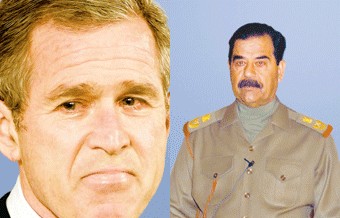 |
|||||||||||||||||
|
|||||||||||||||||
|
In English |
|
 |
Jiri David Kaltio 3/03 The red neon heart Srdce (Heart), sponsored by Nokia and using electricity taken from the Presidential bureau, was lit up on 17th of November, 2002: the 13th anniversary of the Velvet Revolution. The heart beat for two and a half months, reminding of the life-work of Václav Havel, and died out on Havel's last day in the office at the beginning of February . |
|
The heart aroused a heated dispute of the limits of good taste in art. It reminded many of brothel lights; to some it represented mere sucking up to the president. Demonstrators climbed to the base of the work after Havel had signed the declaration of eight EU-countries giving their support to USA. When half of the heart was covered, it turned into a question mark.
The artist himself does not mind the attention his work receives:
The neon heart was clearly connected with Havel; after all, he uses a heart in his signature. A by-stander might wonder, how an idealist became a stern realpolitician: in the beginning of the 90s, Havel demanded the abolishment of Nato in the manner the Warsaw Pact. However, thanks to him, the Czech Republic finally joined the longed-for Nato four years ago. Prague will remain in history as the place where the latest decision for Nato expansion was made. In his last speech, Havel tried to warn Europeans not to leave the United States alone in the war against terrorism. David's Heart served in a way as a lightning conductor: the Parliament who gave the platoons of the Czech army into the use of the alliance was spared from demonstrations, whereas Havel, who declared the common policy of the left-wing and centre party government, and the right-wing opposition to the world, was picked on.
David does not hide his sympathies for Havel, even though the Czech artists of his generation are uneager to take a stand with their work. David's art has been societal since the 80s. David was a member of a group of artists called Tvrdohlaví (the Thick-headed) in the beginning of 1980s. The members of the group were connected by a doubtful or even dismissive attitude towards the Czech canon. David was the conceptualist of the group. The group still exists loosely, and for instance has a permanent show room in the centre of Prague. They have become a part of the canon themselves.
The group aroused international interest already during communism, and David's first own exhibitions abroad were held in Great Britain in 1987-88.
The spirit of the thick-headed has not left David:
Also Bez soucitu (No Compassion) series comprises of manipulated images, in which a group of world's top politicians from Havel to Osama bin Laden and from Putin to Bush pose with tears in their eyes. It is as if they have been caught sentimentalising at work.
Where did No Compassion take off from?
David says he always chooses his technique according to the inner meaning of the subject. After photo series and neon hearts, he has begun to prepare abstract paintings.
No Compassion has received no compassion in the Czech Republic. It was suspected of being some kind of agitation, but it is relevant at times because of war, at times as the reflector of the masculinity of world politics. It has already been exhibited in Viktor Bucher's Projektraum in Vienna, FIAC's Gandy Galerie in Paris, and in Neue Galerie's great war-discussing M_ARS exhibition in Austria's Graz, which is this year's European Capital of Culture. From there, it will move on to Mars-gallery in Moscow at the end of summer.
"Geopolitics rule. The world has artists my age whose work is no different from mine, but in Germany and England they are in a completely different position than I am. Contemporary art reflects them completely differently. When you come from a geopolitically weak area, the wall is hard to break no matter what you do. Unless you move abroad."
"The west is very arrogant towards people who come from elsewhere. It's clear they have enough artists themselves. Why bother to go deep into some Central European or Northern people's experience, into a different memory? It can momentarily freshen up the western art, but it is nearly impossible for an outsider to become an equal partner. That's at least how I have started to feel like."
David himself has, of course, managed to get his foot between the door of the West. His income greatly depends on western buyers. He has a couple of faithful collectors in the Czech Republic, but the National Gallery's Museum of Contemporary Art has not bought anything from him - David withdrew his only work being presented there as a protest against the museum director's autocratic practices. Naturally, his work has been bought to other important contemporary art collections in his home country, and also for instance to the Museum of 20th century art in Vienna, Chicago Art Institute, Ludwig Museum in Budapest and Jack Tilto Gallery in New York. |
|
